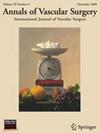Safety and Efficacy of Coil Embolization for Endoleak Prevention as an Adjunct to Endovascular Repair of Abdominal Aortic Aneurysm or Subsequently for the Repair of Endoleak
IF 1.4
4区 医学
Q3 PERIPHERAL VASCULAR DISEASE
引用次数: 0
Abstract
Objective
This study assessed the real-world safety and efficacy of coil embolization during endovascular aneurysm repair (EVAR) of abdominal aortic aneurysms (AAA) for prophylactic endoleak prevention or as a reintervention for endoleak repair, using the Cerenovus family of coils (Cerenovus, Irvine, CA, USA).
Methods
This was a multicenter, retrospective cohort study of consecutive patients who underwent embolization of branching arteries during EVAR of an AAA or as a reintervention for endoleak repair, using Cerenovus coils between January 2017 and December 2021 in Japan. The primary outcome was 30-day reintervention-free survival, defined as cardiovascular mortality or any complication requiring reintervention within 30 days post procedure. Secondary outcomes included conversion to open surgical repair, length of hospitalization, and the following outcomes through 30 days and 1-year post procedure: occurrence of endoleak (Type I-V), reintervention, complications not requiring reintervention, aneurysm-related mortality, coil migration, and all-cause mortality.
Results
A total of 306 patients (mean age 76.7 ± 7.8; 16.7% [51/306] female) were included in the study. Infrarenal AAA were most common (175/306; 57.2%), and the mean aneurysm size was 52.1 ± 10.9 mm. At 30 days, reintervention-free survival was achieved in 96.4% (295/306) of the patients; 9 (2.9%) patients required reintervention, and 2 (0.7%) died from cardiovascular causes through 30 days. One (1/305; 0.3%) patient underwent conversion to open repair. The mean length of hospitalization was 8.6 ± 7.2 days. Complications not requiring reintervention occurred in 3.9% (12/306) of the patients through 30-days and 12.4% (38/306) through 1-year. Endoleak occurred in 2.9% (9/306) of the patients at 30 days and 9.5% (29/306) at 1 year. Coil migration and aneurysm rupture were not reported for any patient. Aneurysm-related mortalities occurred in 0.0% (0/305) at 30 days and 0.3% (1/303) at 1 year. All-cause mortalities occurred in 0.7% (2/306) at 30 days and 3.3% (10/304) at 1 year.
Conclusions
This study demonstrated that the use of Cerenovus coils yielded a high rate of 30-day-reintervention–free survival and low rates of type II endoleak occurrence and recurrence at the target vessel through 30 days and 1 year in patients following EVAR of an AAA with coil embolization, either for prophylactic endoleak prevention during EVAR or as a reintervention to repair an endoleak.
作为腹主动脉瘤血管内修复术的辅助手段或随后用于修复内漏的线圈栓塞术预防内漏的安全性和有效性。
目的:本研究评估了在腹主动脉瘤(AAA)血管内动脉瘤修补术(EVAR)中使用 Cerenovus 系列线圈(Cerenovus,Irvine,CA,USA)进行线圈栓塞以预防性预防内漏或作为内漏修补的再干预措施的实际安全性和有效性:这是一项多中心、回顾性队列研究,研究对象是2017年1月至2021年12月期间在日本使用Cerenovus线圈对AAA进行EVAR期间接受分支动脉栓塞或作为内漏修复的再介入治疗的连续患者。主要结果是30天无再介入生存率,即术后30天内出现心血管死亡或任何需要再介入的并发症。次要结果包括转为开放手术修复;住院时间;以及术后30天和1年的以下结果:发生内漏(I-V型)、再次介入、无需再次介入的并发症、动脉瘤相关死亡率、线圈移位和全因死亡率:研究共纳入 306 名患者(平均年龄为 76.7±7.8;16.7% [51/306] 为女性)。肾下动脉瘤最为常见(175/306;57.2%),动脉瘤平均大小为(52.1±10.9)毫米。在 30 天内,96.4% 的患者(295/306)实现了无再介入生存;9 名患者(2.9%)需要再介入,2 名患者(0.7%)在 30 天内死于心血管疾病。1例(1/305;0.3%)患者转为开放式修复。平均住院时间为 8.6±7.2 天。30天内有3.9%的患者(12/306)发生了不需要再次手术的并发症,1年内有12.4%的患者(38/306)发生了不需要再次手术的并发症。2.9%(9/306)的患者在 30 天内出现内膜渗漏,9.5%(29/306)的患者在 1 年内出现内膜渗漏。未报告任何患者发生盘管移位和动脉瘤破裂。动脉瘤相关死亡率在 30 天内为 0.0%(0/305),1 年内为 0.3%(1/303)。30天内全因死亡率为0.7%(2/306),1年后全因死亡率为3.3%(10/304):这项研究表明,在使用线圈栓塞进行 AAA EVAR 后的患者中,无论是在 EVAR 期间预防性预防内漏,还是作为修复内漏的再干预措施,使用 Cerenovus 线圈都能获得较高的 30 天无干预存活率和较低的 II 型内漏发生率,以及 30 天和 1 年后靶血管的复发率。
本文章由计算机程序翻译,如有差异,请以英文原文为准。
求助全文
约1分钟内获得全文
求助全文
来源期刊
CiteScore
3.00
自引率
13.30%
发文量
603
审稿时长
50 days
期刊介绍:
Annals of Vascular Surgery, published eight times a year, invites original manuscripts reporting clinical and experimental work in vascular surgery for peer review. Articles may be submitted for the following sections of the journal:
Clinical Research (reports of clinical series, new drug or medical device trials)
Basic Science Research (new investigations, experimental work)
Case Reports (reports on a limited series of patients)
General Reviews (scholarly review of the existing literature on a relevant topic)
Developments in Endovascular and Endoscopic Surgery
Selected Techniques (technical maneuvers)
Historical Notes (interesting vignettes from the early days of vascular surgery)
Editorials/Correspondence

 求助内容:
求助内容: 应助结果提醒方式:
应助结果提醒方式:


